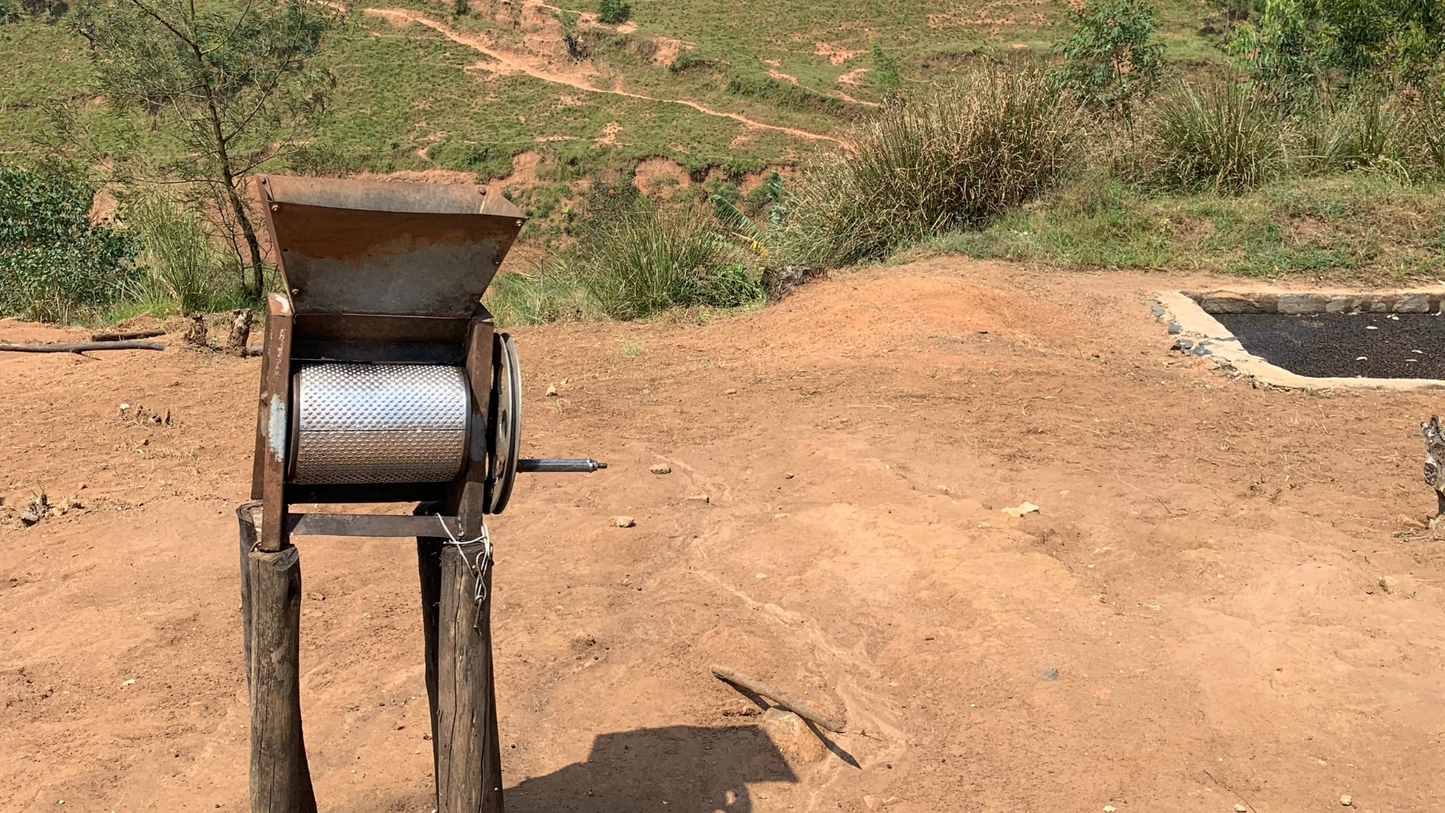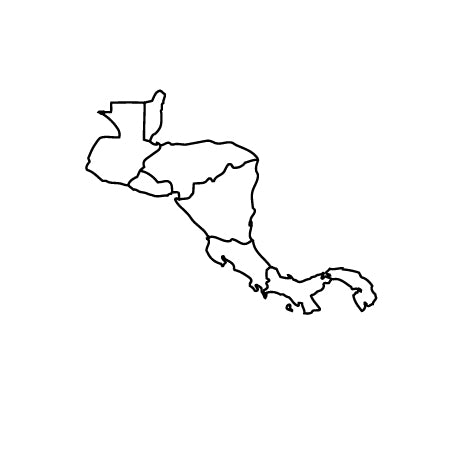

GROWING REGIONS

CENTRAL AMERICA
Coffee made it's way to the Americas in 1723, after a French Naval officer brought a seedling across the Atlantic from France to Martinique. The impact from this voyage had a viral effect. In just 50 years, the small island had grown over 18 million coffee trees, becoming the source of all coffee in Latin America.
While coffee is not a native plant to Latin America, the region is now the largest producer of the crop in the entire world. Although global climate change has and continues to be a threat to the industry, the tropical weather and mountainous geography in both Latin and South America are ideal for growing coffee.
Let's take a look at a few of coffee's best countries in the Americas. Chances are, you've tasted a cup or two from one of these coffee-producing powerhouses.
Costa Rica
Costa Rica is a purist when it comes to coffee processing. Their reputation for high-quality wet-processed, or washed, coffee is second to none in the world. Wet-processing coffee refers to a way of moving coffee through production by removing the fruit coverings of the coffee bean before they're dried. The wet process, which can take farmers up to 80 hours per batch, produces higher quality beans than any other method.
Most of the coffee coming from Costa Rica is produced in smaller farms, grown in mostly volcanic soil. The higher altitudes, rich soil, and wet method of bean processing come together to create roasts that most would describe as bright, balanced, and clean.
El Salvador
The coffee industry in El Salvador has witnessed some ups and downs in the last hundred years or so. Around 1880, coffee became an important fixture in El Salvador's economy and the export continued to thrive throughout the 20th century.
Despite the boom, a civil war in 1980 dramatically impacted El Salvador's coffee lifeline, causing production to decrease and exportation to slow.
The country has managed to slowly bounce back from the catastrophe civil war wreaked on their most important crop. Investing in and implementing new technologies for farming coffee helped renew the industry post-war. Despite the latest in technological advancement, farmers there are proud to still focus most of their efforts on producing the most traditional El Salvadorian variety, Bourbon, which is full-bodied and sweet.
Guatemala
Guatemala might not be the first Latin American country that comes to mind when you think of superior coffee, but make no mistake, Guatemala is small-yet-mighty when it comes to producing some of the world's most complex varieties.
The varieties that come from Guatemala are as diverse as the country itself. The eight different growing regions in Guatemala are affected by different climate and elevation factors, which are reflected in each region's distinct blend.
Guatemala actually has a governing body to oversee this phenomenon and ensure their diversity of regional production is never lost. The Asociación Nacional del Café (Anacafe), ensures coffees from particular regions match up with their respective flavor profile, otherwise, that variety cannot be marked with the official regional designation.

South America
Coffee made its way to the Americas in 1723, after a French Naval officer brought a seedling across the Atlantic from France to Martinique. The impact from this voyage had a viral effect. In just 50 years, the small island had grown over 18 million coffee trees, becoming the source of all coffee in Latin America.
Let's take a look at a few of coffee's best countries in the Americas. Chances are, you've tasted a cup or two from one of these coffee-producing powerhouses.
Colombia
Further south is one of the world's most consistent producers of high-quality coffee beans -- Colombia. With ports to both the Atlantic and the Pacific, it's no wonder Colombia is the world's second largest coffee producer.
Most of the coffee from Colombia is grown at high altitudes at the base of the Andes mountains. This climate yields mild, globally-popular varieties that you might recognize as Colombia Supremo and Colombia Extra.
The mountains that run through Colombia bisect the country to create a diverse set of microclimates and thus, a diverse mix of growing regions. The different growing regions produce, of course, a variety of flavor profiles, but common descriptors include vanilla, tropical fruit, and caramel.|
Peru
Peru might have some tough competition with Colombia right next door, but the country holds it's own when it comes to producing high-quality, flavorful coffees.
We think of Peru as the underdog of South America. While coffee from Peru isn't yet as popular or widespread as other South American crops, the country is home to some “rare gems” in the specialty coffee world.
A large percentage of the coffee exported from Peru is certified Fair Trade organic. Establishing Peru as a Fair Trade marketplace for coffee has not only helped the industry grow more quickly, but it's helped keep quality standards high and consistent.
Here at Tinker, we love the sweet-bodied simplicity and brightness of Peruvian coffee and import new lots as soon as they arrive in the States late in the year.
Brazil
Coffee is big business in Brazil, for both large-scale farms and small, independent farmers alike. Brazil is the world's largest coffee producer and as a result, the country exports an increasingly wide variety of high-quality beans.
A term you might hear used frequently in regards to Brazil's processing methods is “pulped natural” coffee. In this method, coffee berries have been dried with the pulp of the fruit still attached to the beans. This method can be risky -- a lot can go wrong when the fruit is left attached -- but the clean, traditionally Brazilian cup it produces in the end is always worth the challenge.
In all, Brazil is home to some of the finest cups of coffee in the world. Sweet, medium-bodied, and with low acidity, you can never go wrong with a good cup of Brazilian coffee.

AFRICA
Africa is considered by many as the birthplace of coffee. According to legend, coffee was discovered in Ethiopia around 800 AD, by a herder whose goats stumbled across some stimulating berries. Check out our history page for the whole story.
The warm temperatures, rich soil, and high elevations of Africa make it the perfect environment for growing and cultivating some of the best coffees in the world. There are many different countries in Africa that produce amazing coffee, but we'll take a closer look at the three most popular -- Ethiopia, Kenya, and Tanzania -- to give you a more detailed picture of what this lush, wild continent has to offer.
Ethiopia
On top of being the birthplace of coffee, Ethiopia is home to the most valuable plant in the coffee world, Coffea Arabica. That's just a fancy way of saying Ethiopia has a surplus of Arabica coffee on hand. In fact, it's the number one exporter and number one consumer of Arabica coffee in all of Africa.
Many people describe Ethiopian coffee blends as tasting, "the way coffee is supposed to taste." This is a valid description, as Ethiopia also boasts the most diverse range of coffee varieties than anywhere else in … you guessed it … the world. The conditions for coffee are so perfect here, that the plants still grow wild all over the country.
Kenya
Crisp, bright, and citrusy. If we took a global survey, that's how the majority would describe the highly sought-after coffees of Kenya. Because of its approachable yet distinct flavor profiles, Kenyan coffee is widely popular and seemingly loved by all coffee drinkers, novice and connoisseurs alike.
The Kenyan Coffee trade operates within a unique business model. Every week, on Tuesdays, coffee is auctioned at the Nairobi Coffee Exchange. This free-market approach to coffee production allows farmers to dedicate more focus on cultivating top-quality coffee, as they know they'll get a fair price from numerous eager buyers.
Kenya started utilizing the auction system in 1933 and still use it today to sell most of their nation's coffee.
Tanzania
In Tanzania, most of the nation's coffee is grown under banana trees at the base of Mount Kilimanjaro … Sounds gorgeous, right?
Tanzania has developed a unique specialty in the coffee world: peaberries. Peaberries are different than typical coffee beans, and are typically hand-sorted as they go through processing. Inside the coffee cherry in which peaberries grow there is only one rounded bean as opposed to the typical two, flat-sided beans.

asia
Coffee production in Asia is the source of one of coffee's most popular modern nicknames -- Java. The Dutch brought coffee seeds to the island of Java in the early 1700's. Their planting was, of course, wildly successful, solidifying the region's future as a global leader in coffee production.
While India is responsible for a reasonable percentage of coffee production in Asia, most of the region's exportation business stems from the exotic growing regions of Southeast Asia.
Indonesia
Chances are, you've heard of some of the major growing regions in Indonesia like Bali, Sumatra, Java, and Sulawesi. Indonesia is an archipelago state three times larger than Texas. The warm, damp climate of the region produces coffees with deep body, low acidity, and earthy notes -- a flavor profile that mimics the beautiful, tropical landscape of the islands.
Vietnam
Vietnam only recently established itself as one of the top producers of coffee in the world. The industry started gaining traction there in the 1990's, when the World Bank saw a major business opportunity in exporting beans from there.
The coffee that comes from Vietnam is of the Robusta variety. Similar to the beans that come from Peru, beans from Vietnam are great for blending and adding flavors. With light acidity and and a mild body, Vietnam pours a balanced cup enjoyed by the masses.

